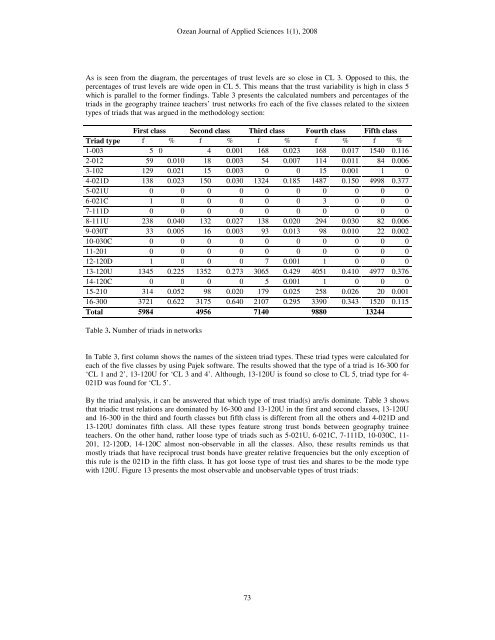Journal of Applied Science Studies - Ozean Publications
Journal of Applied Science Studies - Ozean Publications
Journal of Applied Science Studies - Ozean Publications
Create successful ePaper yourself
Turn your PDF publications into a flip-book with our unique Google optimized e-Paper software.
<strong>Ozean</strong> <strong>Journal</strong> <strong>of</strong> <strong>Applied</strong> <strong>Science</strong>s 1(1), 2008<br />
As is seen from the diagram, the percentages <strong>of</strong> trust levels are so close in CL 3. Opposed to this, the<br />
percentages <strong>of</strong> trust levels are wide open in CL 5. This means that the trust variability is high in class 5<br />
which is parallel to the former findings. Table 3 presents the calculated numbers and percentages <strong>of</strong> the<br />
triads in the geography trainee teachers’ trust networks fro each <strong>of</strong> the five classes related to the sixteen<br />
types <strong>of</strong> triads that was argued in the methodology section:<br />
First class Second class Third class Fourth class Fifth class<br />
Triad type f % f % f % f % f %<br />
1-003 5 0 4 0.001 168 0.023 168 0.017 1540 0.116<br />
2-012 59 0.010 18 0.003 54 0.007 114 0.011 84 0.006<br />
3-102 129 0.021 15 0.003 0 0 15 0.001 1 0<br />
4-021D 138 0.023 150 0.030 1324 0.185 1487 0.150 4998 0.377<br />
5-021U 0 0 0 0 0 0 0 0 0 0<br />
6-021C 1 0 0 0 0 0 3 0 0 0<br />
7-111D 0 0 0 0 0 0 0 0 0 0<br />
8-111U 238 0.040 132 0.027 138 0.020 294 0.030 82 0.006<br />
9-030T 33 0.005 16 0.003 93 0.013 98 0.010 22 0.002<br />
10-030C 0 0 0 0 0 0 0 0 0 0<br />
11-201 0 0 0 0 0 0 0 0 0 0<br />
12-120D 1 0 0 0 7 0.001 1 0 0 0<br />
13-120U 1345 0.225 1352 0.273 3065 0.429 4051 0.410 4977 0.376<br />
14-120C 0 0 0 0 5 0.001 1 0 0 0<br />
15-210 314 0.052 98 0.020 179 0.025 258 0.026 20 0.001<br />
16-300 3721 0.622 3175 0.640 2107 0.295 3390 0.343 1520 0.115<br />
Total 5984 4956 7140 9880 13244<br />
Table 3. Number <strong>of</strong> triads in networks<br />
In Table 3, first column shows the names <strong>of</strong> the sixteen triad types. These triad types were calculated for<br />
each <strong>of</strong> the five classes by using Pajek s<strong>of</strong>tware. The results showed that the type <strong>of</strong> a triad is 16-300 for<br />
‘CL 1 and 2’, 13-120U for ‘CL 3 and 4’. Although, 13-120U is found so close to CL 5, triad type for 4-<br />
021D was found for ‘CL 5’.<br />
By the triad analysis, it can be answered that which type <strong>of</strong> trust triad(s) are/is dominate. Table 3 shows<br />
that triadic trust relations are dominated by 16-300 and 13-120U in the first and second classes, 13-120U<br />
and 16-300 in the third and fourth classes but fifth class is different from all the others and 4-021D and<br />
13-120U dominates fifth class. All these types feature strong trust bonds between geography trainee<br />
teachers. On the other hand, rather loose type <strong>of</strong> triads such as 5-021U, 6-021C, 7-111D, 10-030C, 11-<br />
201, 12-120D, 14-120C almost non-observable in all the classes. Also, these results reminds us that<br />
mostly triads that have reciprocal trust bonds have greater relative frequencies but the only exception <strong>of</strong><br />
this rule is the 021D in the fifth class. It has got loose type <strong>of</strong> trust ties and shares to be the mode type<br />
with 120U. Figure 13 presents the most observable and unobservable types <strong>of</strong> trust triads:<br />
73

















